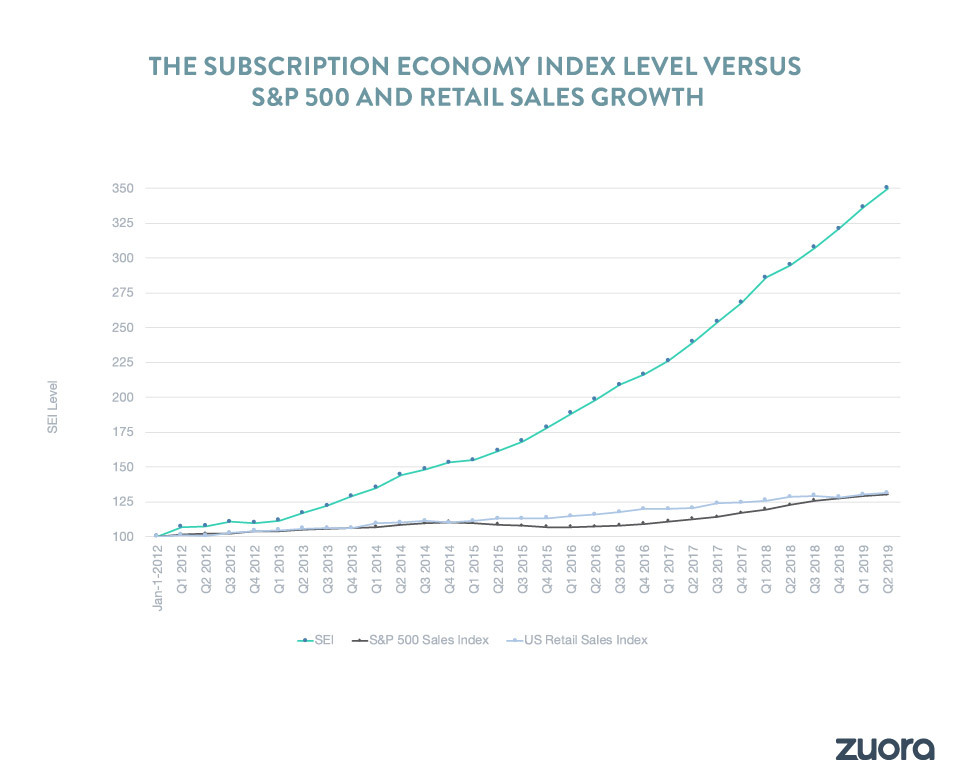In a latest report highlighting the growth of subscription economy, SaaS and IoT have achieved the highest level of subscription revenue growth since Q2 2017. The report also marks entry of Manufacturing, Telecommunications and Publishing industries.
No two subscribers are same. They have different levels of interest in a product, and are more than willing to pay for their choice.
Recommended: How Well Does Amazon’s MarTech Understand Its Customers?
SaaS Organizations Selling in the Subscription Economy Bring Phenomenal Value to the Digital Age
Contemporary subscription businesses are shifting from being product-based to a more complex deal-based arrangements where customers get to choose and remove product features based on their business needs. As more and more Subscription-based businesses (especially dealing in SaaS) learn about their customer choices and deliver on their true needs, we see a remarkable growth in their Sales. According to Zuora’s latest Subscription Economy Index, the subscription-based revenue has grown by over 350%. The major factors driving this economy are linked to consumer’s ever-growing demand for highly-personalized digital services, and frequent interactions with online sales channels.
“The Subscription Economy is not limited to one or two industries. We’re now seeing sectors far and wide placing subscriptions, over pure-play products, at the center of their businesses to achieve rapid and sustained long-term growth,” said Dr. Carl Gold, Chief Data Scientist at Zuora.
Dr. Carl added, “The SEI report showcases the transition to subscriptions beyond the boundaries of traditional SaaS organizations into the Manufacturing and Business Services sectors, exposing the phenomenal value of the subscription business model in today’s digital age.”
Read Also: How to Raise Your Marketing Strategy to a Whole New Level …
The latest SEI report showcases a number of industries contributing to this incredible growth. On average, Zuora found that the sectors outlined in the SEI report are growing 2 to 5 times faster than their industry benchmarks.

Digital Services Popping Out New Growth Channels
Over the past seven and one half years, the Subscription Economy® has continued to thrive, growing more than 350 percent, as consumers increasingly demand access to convenient, digital services over the ownership of physical products.
By 2020, 50 percent of the world’s largest enterprises will see the majority of their business depends on their ability to create digitally enhanced products, services, and experiences, says IDC.
Key industry findings from the SEI report which support the Subscription Economy’s long-term magnitude and viability in various industries include:
- Business services and manufacturing industries experienced the lowest churn rates across all sectors, with 16.2% and 20.4% churn rates, respectively. However, Media (37.1%) and Publishing (28.2%) industries saw the highest amount of churn.
- IoT and manufacturing subscription companies exceeded their industry S&P 500 benchmarks by more than 5X. IoT subscription businesses also achieved the highest annual growth rate of Average Revenue Per Account (ARPA) at 14.3%, more than 2x the SEI average of 6.5%.
- The publishing industry generated the least amount of revenue from usage-based pricing compared to other industries at 17%, while the sector with the highest percentage of usage-based revenue was Business Services (57%).
Churn Rates in Subscription Economy Depend on Usage-based Pricing; Publishers Lag Behind SaaS and Services
Overarching Subscription Economy insights derived from these industry findings include:
- Offering subscriptions that serve business-critical functions experience lower customer churn. According to Dr. Gold, “Lower churn could be attributed to the ‘sticky’ nature of B2B subscriptions, which serve mission-critical functions and tend to be deeply embedded within a business’ operations. It could also indicate that new entrants shifting to subscriptions are learning from first-movers to the business model.”
- Launching and monetizing new services drive greater individual account growth. According to Dr. Gold, “Add-on and up-sell opportunities inherent in digital services and connected hardware support high ARPA growth rates.”
- Incorporating usage-based pricing facilitates lower churn and higher overall subscription growth. According to Dr. Gold, “Companies in industries like publishing that do not adopt usage billing generally have higher churn than companies like those in SaaS or Business Services that do. This suggests that the balance and flexibility of usage-based pricing plays a useful role in customer engagement and retention.”
Read More: CMS Distribution Acquires Avesta to Expand French Market
Currently, Zuora provides these to the subscription economy-
- Zuora Central
- Zuora Billing
- Zuora CPQ
- Zuora RevPro
- Zuora Collect
- Zuora Marketplace
Competitors of Zuora
- Chargify
- Sage Intaact
- Salesforce CPQ
- APTTUS
- Icertis
- SpringCM
- Oracle CPQ Cloud
As we inch closer to 2020, we expect CPQ businesses to continue with their embrace of Mobile CPQ, Customer Experience platforms, and guided selling approaches based on ABM Orchestration, Intent Data, and Automated Pricing models for every subscriber, from every industry. B2B decision-makers would continue to rely on Mobile CPQ providers to “build quotes, work proposals and configure products” that are absolutely essential to delivering quotes to leads in a timely and effective manner.
Recommended: MarTech Interview with Larry Kim, Founder and CEO at MobileMonkey












Comments are closed.